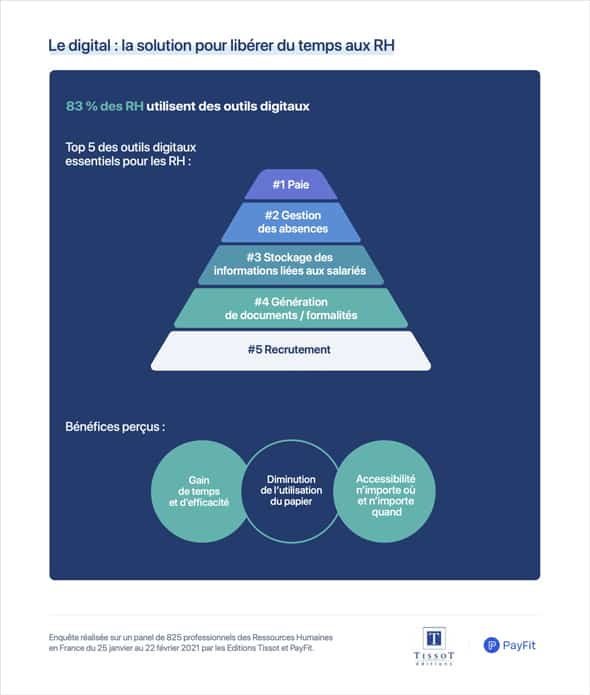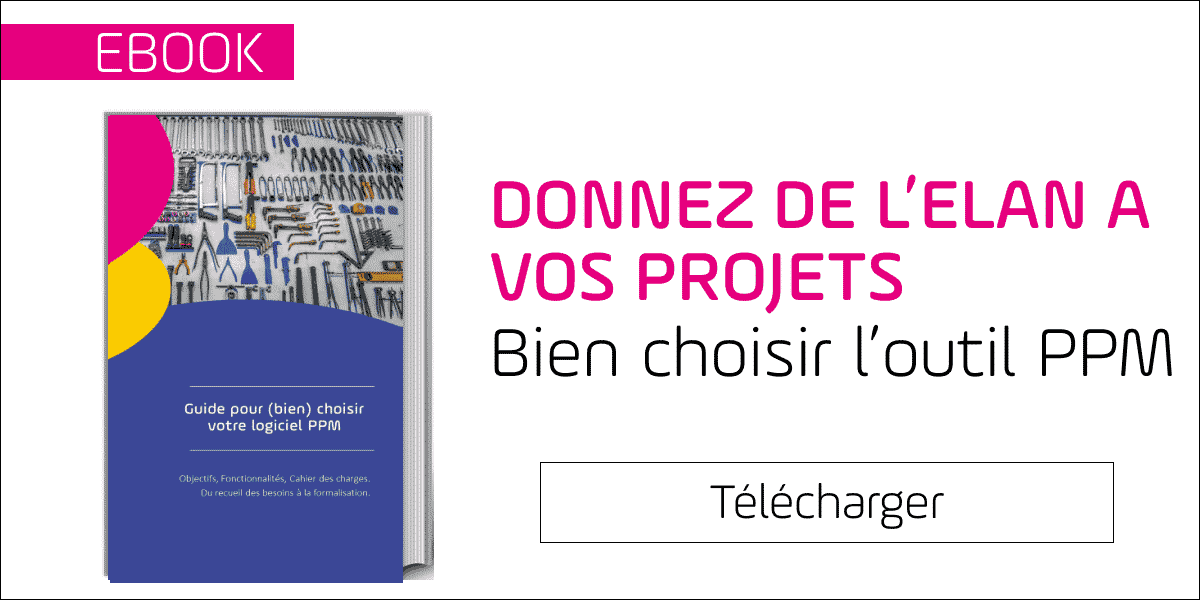Digitizing HR & HRIS: what challenges for CIO in 2022?
HR projects for 2021 have logically been influenced by the context of the COVID-19 distance learning project. The emphasis is on facilitating new ways of working in an uncertain and long-term situation. The digitization of HR must be aligned with the challenges challenges facing CIO. These include space management software, collaborative working tools and cybersecurity management. And what about 2022? For the 4th year running, Editions Tissot and PayFit conducted a survey of 825 HR professionals. The results show that 90% of HR professionals are convinced that adopting digital tools will enable them to be more efficient and save time.
Find out more in this article:
- Understanding the importance of HR digitization
- The role of CIO in HR data management
- Our tips and tools for effective and efficient collaboration between HR and CIO
Understanding the importance of HR digitization
HR digitization encompasses all the processes involved in dematerializing HR practices and tasks. In a context of digital transformation, digitizing HR is of vital importance to companies.
To take full advantage of the many benefits of digitalization, CIO has a key role to play. In particular, HR digitization makes it possible to:
- Fewer errors when managing multiple tasks
Thanks to HR digitization, the mistakes made in the past through typing errors or carelessness are a thing of the past. The management of expense claims, absences, leave and pay slips is made easier and more efficient.
- Greater reactivity and faster decision-making
The many advantages offered by HR digitization (better employee management, predictive recruitment, enhanced data confidentiality, etc.) also enable smoother decision-making.
- Compliance with RGPD standards
A management tool for dematerializing HR complies with legal constraints. In particular those of the RGPD imposed by the European Parliament regarding the protection and processing of sensitive data.
- Digital is a solution to free up HR time
According to the Baromètre 2021 : les RH au quotidien - Editions Tissot - (editions-tissot.fr), for HR the 5 subjects for which digitalization is essential are :
- payroll management,
- absences,
- storage of employee-related information,
- document generation
- and recruitment

💡 3 essential solutions for building your HRIS
Integrate a solution to digitalize your company's Human Resources . Processes are simplified, time spent on administrative management is reallocated to more strategic missions, and money is saved.
Lucca's HR software suite, for example, offers an HRIS Essentials Base consisting of 3 solutions for automating HR processes:
- Personnel management: Poplee Core HR
- Leave and absences: Figgo
- Interviews & Goals: Poplee Interviews & Objectives
The role of CIO in HR digitization
Thanks to new technologies, it is now possible to automate a number of tasks in order to save time, and therefore productivity. But to achieve these goals, the participation of CIO in the HR digitization project is essential.
As IT experts, CIOs have a new role to play in HR digitization. Formerly executors, IT department specialists now occupy a strategic role.
The increasing integration of HRIS by companies to facilitate, optimize and better manage all HR tasks requires the intervention of CIO to help Human Resources automate a certain number of actions thanks to the right tools, and to begin the company's overall digitalization process.
In concrete terms, CIO has 4 roles to play:
- Coordination role: in charge of information systems. He/she is responsible for coordinating the work of the IT department in the digitalization of the company's various divisions.
- Strategic role: ensures optimization, proper use of applications and security of the company's information system.
- Technological role: CIO is in the front line when it comes to new technologies and digital solutions. It's up to her to drive changes aimed at modernizing internal processes.
- Support role : CIO helps to modernize and automate all company departments: finance, sales, marketing, HR, etc. Human Resources is often the least equipped department, so the IT team must be there to support them in their digital transformation.
HR and CIO : Our tips & tools for efficient and effective collaboration
Collaboration between HR and CIO is a key success factor in a company's digital transformation. To ensure that the results pay off, 5 tips can be put in place.
1. Enhanced internal and external communication
For internal communication, CIO, in close collaboration with HR, needs to set up a communication system based on a collaborative tool (e.g. cloud) to streamline and fluidify communication.
For external communication, the IT department and CIO must ensure that the tabs used to contact the company are visually pleasing and technically optimized.
2. Facilitate employee onboarding
Combining onboarding and digital means saving precious time for HR and managers, and offering your employees a memorable experience. Using a digital onboarding tool is a strength that makes the employee experience ever more personalized and innovative. In a hybrid working environment, a digital platform is all the more necessary.
3. Anticipating new ways of organizing work and facilitating teleworking
In its study "COVID-19 and the future of business", IBM reveals that 68% of French executives plan to prioritize remote working for their employees over the next two years. While this has been relatively straightforward for already digitalized structures that have already integrated telecommuting into their operating methods, for others it has meant a total rethink of their organization and working methods.
💡 Use project portfolio management software to facilitate change management
How do you manage the various phases associated with this new remote organization? Training, renewal or extension of IT equipment, cybersecurity... These are all stages that can be difficult to manage on a large scale.
Project portfolio management software is a good solution for managing the phases, milestones, resources required for CIO, schedules and budgets. An all-in-one solution for centralizing the various functions needed to manage this type of project.
4. Setting up an Identity and Access Management (IAM) system
To facilitate dialogue and promote exchanges between the two services, a common "language" is needed. Once said, done: that's what IAM tools are for.
IAM is the French acronym for "Identity and Access Management", and refers to internal processes for administering and managing user accounts, access rights to applications and systems, and corporate resources.
IAM links HR and CIO. Such a project enables both HR and IT departments to be involved. It also significantly reduces the risk of identity theft, data leakage and unauthorized access.
5. Supporting the HR data management system
The HR department accumulates a large volume of sensitive data. However, HR teams do not necessarily have the skills to use and manage this data correctly (extraction, grouping, presentation...). This is where the support of the IT department comes in. It is there to make suggestions and help HR learn how to use the data.
